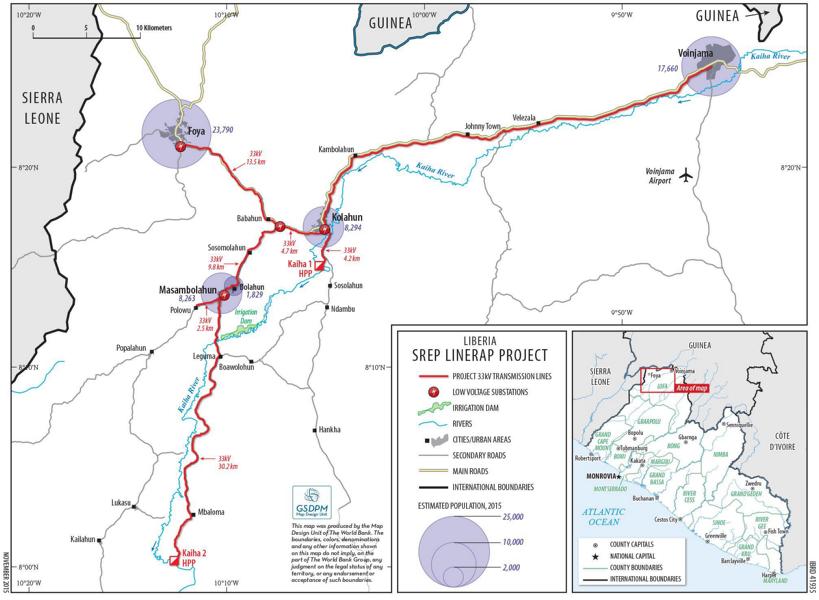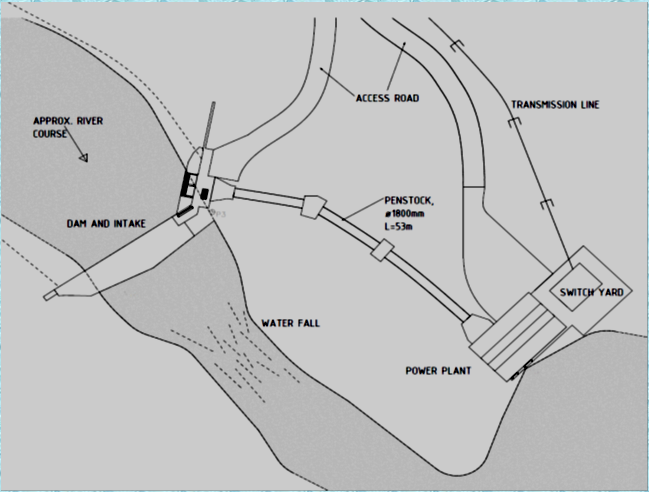
The first component of the Liberia Renewable Energy Access Project (LIRENAP) aims to create access to affordable, reliable, year-round electricity services to at about 50,000 people in North Lofa County by establishing a first mega-watt scale hydropower grid backed up with thermal generation based on diesel. The estimated costs are US$22 million, of which the World Bank within SREP provides US$20 million and IDA gives US$2 million for the Diesel back-up system. The Rural Renewable Energy Agency (RREA) implements the project.
Implementation Area: Lofa
Lofa is an economic and agricultural hub in Northwest Liberia close to the border with Guinea and Sierra Leone. The county was one of the hardest hit during the Ebola outbreak. It is more than 200 km from the national grid, and there are no prospects in the medium term to provide service from the national grid. The decentralized grid is planned to focus on the towns of Vonjaima, Foya, Kolahun, and Massambolahun/Bolahun and surrounding areas.
Currently, some large businesses in the area such as agricultural processing plants, as well as commercial and public entities have their own diesel generators. Households and small businesses do not have any electricity services or have limited, unreliable, and expensive electricity supply from informal diesel generators.
The electricity demand of the mini-grid includes agricultural processing and other productive and commercial uses as well as household needs. Therefore, a reliable and continuous supply of electricity is needed, also reaching large customers from 20 kW to 100 kW, including hospitals and large educational centers. Several productive uses such as stores, sugar crushers, palm oil processors in the range of 5-10 kW have been also identified. Four percent of the potential connections will be for commercial or institutional users, which represent almost 50 percent of the electricity demand.
Electricity Generation and Distribution
A hydropower plant near Kolahun on the Kaiha River is to provide electricity during the wet season (approximately eight months). Diesel generation can be used during the dry season (approximately four months of the year), in order to provide reliable service for productive activities year round.
The proposed layout of the hydropower plant consists of a small weir and intake structure upstream of the waterfall, a short penstock and a power station downstream. It has an approximate total head of 13 meters (five meters high weir and eight meters head difference); the design discharge of the power plant would be 7.5 m3/s. This layout for the plant would optimize the use of the hydro resources, allowing the plant to generate some electricity even during the dry season, complemented by diesel generation.

Operation and Management
An Owner’s Engineer will assist RREA with overall management and supervision of the procurement, design, construction, management, and operations and maintenance (O&M) arrangements, as well as coordination of the implementation of the Environmental and Social Management Plans (ESMPs) and Resettlement Action Plans (RAPs).
Technical assistance will be provided to define O&M arrangements and the tariff required to ensure sustainability of the mini-grid, building on the IPRE, which outlines a range of O&M business models, and ongoing work on such business models by international consultants financed by USAID and the government of Norway.
Economic, Financial and Technical Analyses
Economically, this project is found viable with an economic internal rate of return (EIRR) of 18 percent and a net present value (NPV) of US$11.5 million at a 10 percent discount rate. Economic benefits were estimated conservatively based on avoided costs of electricity substitutes such as diesel generators, dry cell batteries, kerosene lamps, candles.
A tariff of US$0.26/kWh is found to be cost-reflective. This is approximately half of the current average tariff in Liberia. Since the capital costs of the mini-grid will be mostly grant financed, its financial viability was determined by estimating the average electricity tariff required to recover the costs for operation and management (including generation costs, client service within the area of the mini-grid, non-technical losses), and to yield a financial rate of return equal to 14 percent (pre-tax values) on the working capital needed by the operator.
A comparative analysis of a number of technology alternatives taking into account local circumstances suggested a combination of hydropower and diesel technologies. The hydro/diesel option has the lowest capital cost to provide uninterrupted electricity service for households and productive uses. Lofa County’s small hydro resources can meet peak demand during eight months of the year. Diesel is easily available given its uses in transport and agricultural production.
Hydro/solar with batteries present the highest capital costs and the option of hydro/solar without batteries is too intermittent for productive uses (no energy in the night during the dry season). A triple technology mix (hydropower, solar PV, and diesel) is too expensive because solar PV would not be used during eight months and the reduction of diesel/thermal generation needs would only affect the four months of the dry season. While a hydropower/diesel mix results in a higher tariff than other options, the US$0.26/kWh tariff is well below the current US$0.52/kWh paid by LEC customers.
The technologies to be used are commercially available, well-known, and in use in other countries in Sub-Saharan Africa. Initial findings of the prefeasibility on hydropower sites show that the best sites for development are two sites in Lofa County. The final results of the prefeasibility study will be used to validate the site selection and technology configurations.
Project Updates
March 2017: Roundtable Conference for IPPs
On March 16, 2017, the Rural and Renewable Energy Agency convened a Roundtable Conference at the Corina Hotel in Sinkor, Monrovia, for Independent Power Producers (IPPs) and Potential mini-grid operators in Liberia. The purpose of the meeting was to introduce the Liberia Renewable Energy Access Project (LIRENAP) to Independent Power Producers in Liberia and to collect data on potential mini-grid operators. The discussion among all 35 stakeholders highlighted important aspects. Some points raised in the discussions:
- A prepaid system of metering should be used in order to eliminate the need for meter readers as found in the postpaid system.
- It would be good to provide the opportunity to Liberian owned business and professional groups to operate and manage the mini-grid.
- There should be 2 operators; one to manage the technical aspects of the mini-grid and one to manage the commercial aspects. This, of course, would depend mainly on the technical and financial capacity of the operator(s).
- Participants asked whether the ownership of the mini-grid could be eventually transferred to the operators as it was stated that although the mini-grid would be operated by the private sector, it would be owned by the Government of Liberia.
- The issue of a current lack of regulation in the energy sector was continuously raised and when the question of the financial and technical capacity of the potential operator was raised, it was suggested that the incoming regulator should be the one to determine the financial and technical capacity of the mini-grid.
- On the issue of the financial capacity of the operator, participants were informed that it was proposed during the financial and economic analysis of the project that operators provide an initial investment of five hundred thousand United States Dollars ($500,000.00).
- It was a general consensus that for the purpose of building the capacity of the operator, they should come on board as soon as construction commenced.
- Participants lauded RREA for initiating the discussion and prayed that the RREA would take the lead in the development of the energy sector by setting up a system that would allow equitable growth for local businesses in the sector.
- Participants stressed the need for building local capacity within the energy sector if RREA was indeed interested in getting local operators to O&M the mini-grid. They cited the limited number of technicians as a major challenge in targeting local participation.
- It was disclosed that the Millennium Challenge Account (MCA) was soon to invest in a technical training center at the LEC and Booker Washington Institute (BWI) to help strengthen the local capacity within the energy sector
- On the issue of the sustainability of the mini-grid, it was shared that the CAPEX for the mini-grid comes from the World Bank grant, and the operator would come on board with the ability to O&M the mini-grid, and the maintenance of the system would be derived from the tariff that would be collected.
